The true face of Shakespeare: further evidence of its authenticity
Although a Harvard academic claims a 1749 book has proof that Shakespeare’s rebus in The Herball is a printer’s mark, Mark Griffiths explains that this is an error that was corrected in later editions of Typographical Antiquities.
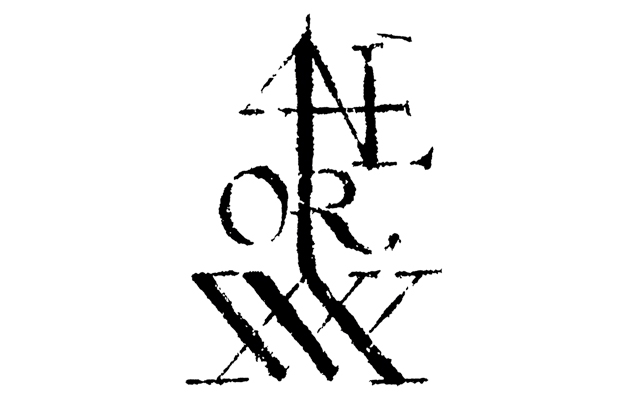
We expected that a storm of controversy would be provoked by the article in Country Life (May 20) in which I identify William Shakespeare on the title page of John Gerard’s Herball. What we had not anticipated is that some academics would rush to dismiss it without even having read the article – this was, indeed, an incredible revelation.
On page 129, I wrote that, although it looked like a publisher’s or printer’s mark, the cipher at bottom right of the title page ‘doesn’t belong to any of the Nortons’, the family of London stationers, one of whom, John, was Gerard’s publisher, ‘or to Edmund Bollifant, the printer of The Herball’. This fact was something that I and my Oxford colleague Edward Wilson had established and tested over a period of years.
On May 19, a day before my article’s publication, and having seen it trailed on BBC News, John Overholt of Harvard University tweeted: ‘Stand back, everybody. I’m about to crush a dream.’ He displayed the note on The Herball that appears on page 433 of Typographical Antiquities by Joseph Ames (1749). It reads: ‘This curious Folio has the mark of William and John Norton together in a cypher.’ This, Mr Overholt thought, destroyed my case. What I saw as an ingenious coded symbol was really nothing more exciting than the mark of The Herball’s publishers. How ignorant, fanciful and idle of me.
Cipher wrongly identified by Ames
I long ago concluded that Joseph Ames was wrong about this cipher. He had, rather, assumed it was the mark of John and William Norton – a natural assumption given its position on the title page, that it’s pretending to be one of the commonest kinds of stationer’s and printer’s identifiers and that it appears to include N and does include O, R, W.
Ames was not infallible. For example, he stated that John Norton was ‘The queen’s printer’ when, in fact, he received no such appointment from Elizabeth I. In the 1786 edition of Typographical Antiquities, the editor William Herbert corrected this error; he also removed the inaccurate assertion that the cipher on the title page of The Herball was the mark of William and John Norton (vol. 2, page 1,216).
Who were the Nortons?
Exquisite houses, the beauty of Nature, and how to get the most from your life, straight to your inbox.
Before I go on, some dramatis personae. The Nortons were William, who died in 1593/4; Bonham, his son and business heir; and John, William’s nephew, apprentice and thereafter a stationer in his own right and independently of his uncle. John and Bonham shared the cost of printing The Herball, but the venture was primarily John’s, hence his name alone on the title page. He landed the project on account of his contacts with Continental publishers of botanical works. The risk was chiefly his; the book was sold from his shop. William was four years dead when The Herball was issued; he’d played no part in its commissioning or production. Why, as Ames assumed, would its title page have a joint cipher identifying him and John as the book’s publishers?
Not a Norton device
In Printers’ and Publishers’ Devices in England and Scotland 1485–1640 (1913), Ronald B. McKerrow gathered the Nortons’ known devices. He did not recognise the cipher on the title page of The Herball as one of them. Nor has it been ascribed to the Nortons in any of the bibliographical studies undertaken to supplement McKerrow’s great survey.
I could have left it at that – this is not a Norton device. But I decided to consult all available records and biographical sources for John Norton to see if there was any reason why, in 1597/98, he would have adopted a new, possibly unique device to reflect his relationship to an uncle who was fully four years dead and with whom he’d had no partnership so signified before. I could find no such reason.
Even Bonham had stopped using his father’s devices soon after his death. There was no warrant for identifying William posthumously on the title page of a book in which he’d had no involvement. But even that wasn’t good enough for me, so I scoured every extant Norton publication, looking for this cipher. I found it nowhere except in The Herball. Moreover, I found telling consistency among the genuine Norton identifiers in these publications.
The true Norton marks
As McKerrow had shown, William used a rebus in which the letters ‘nor’ appear on the side of a barrel (a tun) impaled by Dianthus (aka ‘Williams’), i.e. ‘William(s) nor-tun’. On the root of the Dianthus is the letter W, also for William.
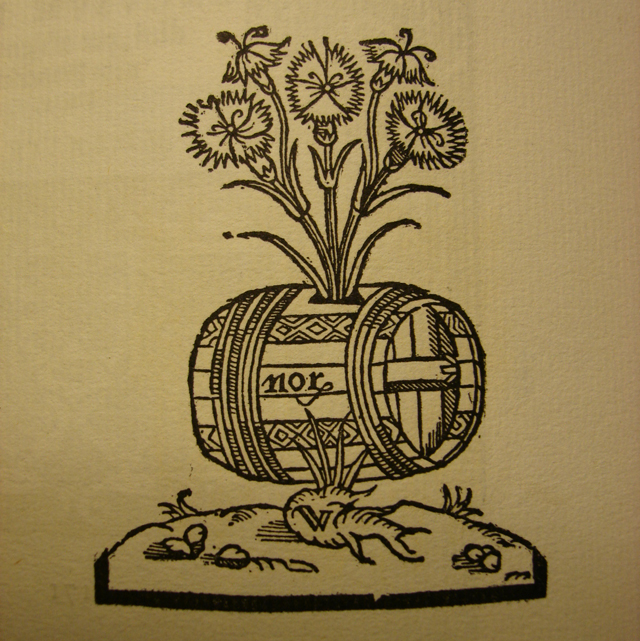
By contrast, John and Bonham used more elegant and elaborate pictorial devices: Mercury’s caduceus; allegorical depictions of Truth; the grafted olive tree of Romans 11. Alternatively, their names were spelt out on title pages and in colophons elsewhere and accorded a prominence that was new at the time.

This is the case with The Herball, where ‘Imprinted at London by Iohn Norton’ appears on the title page in rather bolder lettering than ‘John Gerarde’ above it. These two cousins were socially ambitious and had ambitions for their profession. Rebuses and sign-of-four identifiers were too old-fashioned and artisan for them. As I remained worried that I might have missed a Norton mark somewhere, Edward Wilson, Emeritus Fellow of Worcester College, Oxford, undertook to make a similar sweep. His findings concurred with mine.
Why is it not a Norton cipher?
But one didn’t even need to know the above to see that this was not the joint cipher of William and John Norton. Consider the following:
1. It is not a genuine sign of four. Such identifiers might have the 4 element at the top the right way around or back to front, but it’s always 4 – not a triangle as here. That fact is important; the unalterable character of the numeral 4 goes to the symbol’s origins in ‘Chi Rho’ ([Greek letters] Χ superimposed on Ρ), standing for Christus Rex. It’s a sacred talisman, not to be messed with – unless you’re trying to signify something very different.
2. The cipher does not contain I (or J) for John Norton. The letter at top right is without doubt E. To determine that, I examined all other known extant specimens of William Rogers’s lettering. Where, as in this case, he was pushed for space, he radically shortened the top bar of E to something like a serif.
If you examine the top bar of this letter in a first impression of the first edition title page (i.e. issued before spring 1598), you can see a faint line, a sort of graphic stutter, where he’s taken the pressure off his burin as he’s feared running out of room – there’s no doubt it’s E. That being so, of what use could such a prominent E possibly be in a cipher meant to convey ‘William and John Norton’? Or, if one insists on seeing L or £ rather than a Rogers E, of what use would they be?
3. What, at first sight, looks like N (a letter essential to Ames’s and now Overholt’s presumed ‘NOR’ component) isn’t N at all. William Rogers was remarkably consistent with N: he always engraved its diagonal with a heavier line than its verticals, and he would certainly have done so here had it been the all-important initial letter of Norton.
4. Opposite, under Burghley, is a shield that appears to be a coat of arms – but it isn’t. It is, rather, a device that uses heraldic elements, that pretends to be a coat of arms in order to convey a message. As such, it’s in keeping with the encoded, typically Cecilian cleverness of this title page: things aren’t what they seem.
Surely the same mentality would also have given rise to the cipher opposite? It is not a real sign of four, not a genuinely straightforward and lowly identifier, but something much more sophisticated.
5. There is growing acceptance that three of the four figures on the title page are who I say they are; that the man at bottom left is Lord Burghley and that the shield under him relates to him. Given which, how would ‘John and William Norton’ relate to the Fourth Man? Is this laureate thespian opposite the Lord Treasurer really a publisher? I think not.
And it's not Bollifant's cipher
For the sake of completeness, I should also point out that the mark under the Fourth Man does not belong to Edmund Bollifant, the printer of The Herball, or to his associates in the printing house at Eliot’s Court. Bollifant’s policy on self-identification resembled that of the Nortons, so much so that their devices can be hard to tell apart – pictorial graphics or plain colophons that stated the role he had played, but never the Sign of Four. That is the case in The Herball, where a colophon on the last page simply states: ‘Imprinted at London by Edm. Bollifant, for Bonham and Iohn Norton. M.D. XCVII.’
Nor could the Fourth Man’s mark be an engraver’s mistake. It appears in the same form on all known copies of both impressions of the first edition title page. Any error in this device would have been easy to put right, and top of Norton’s, or Bollifant’s, list of corrigenda.
Nor does the shield belong to the Nortons
I should also head off possible objections to my statement in the article that the shield under Burghley is not the coat of arms of any of the Nortons. It contains an ermine maunch, a charge found in the arms of Norton, a family of ancient gentry and nobility originally based in Yorkshire. This has led some commentators to suppose that the coat of arms on Burghley’s plinth belongs to John Norton. But heraldry does not work like that: an ermine maunch does not say ‘Norton’; nor do all Nortons have the right to display it.
The publishing Nortons belonged not to the Yorkshire clan, but to an unrelated family of Shropshire yeomanry. John Norton never received a grant of arms. His uncle William was awarded arms in late 1593, but this grant attracted censure from some of the younger Heralds. Duly chastised, the publishing Nortons formally relinquished William’s arms soon after his death in early 1594. It was not until 1611 that John’s cousin Bonham, by then a country squire and publisher to the King, was granted a coat of arms. It did not resemble the one on Burghley’s plinth; nor did the late William Norton’s – in both, the colours are different and there is no maunch.
With the Heralds’ rebukes still ringing in their ears, it is unthinkable that John and Bonham Norton would have sported illegitimate or fictitious arms in 1597, let alone printed them on the title page of their most important publication to date. Still less thinkable is that the Lord Treasurer would have tolerated being perched on an emblem that was not his. As I say in my Country Life article, this is not an official coat of arms. When consulted by Edward Wilson, no less an authority than the College of Arms kindly examined this shield and confirmed that this was this case.
Elizabethans and riddles
For the tweeting Mr Overholt of Harvard, the very phrase ‘Cracked the Tudor Code’ was a sure sign that I’d done nothing of the kind. However, social, political and art historians accept that the Elizabethan elite loved codes, riddles and cryptic iconography. For some Elizabethans – the Cecils especially – they were not just a source of pleasure and pride, but a day-to-day practice and a matter of life and death. Books such as William Camden’s Remains and George Puttenham’s Arte of English Poesie are rich in such devices and explanations of their meanings and function.
We also know that examples appear in Shakespeare’s works and that he was handsomely rewarded on at least one occasion for designing one. In finding it so implausible that such a symbol could relate to Shakespeare on the title page of a work sponsored by Burghley, Mr Overholt shows much the same grasp of the elite Elizabethan mentality as he does of publishers’ marks from her reign.
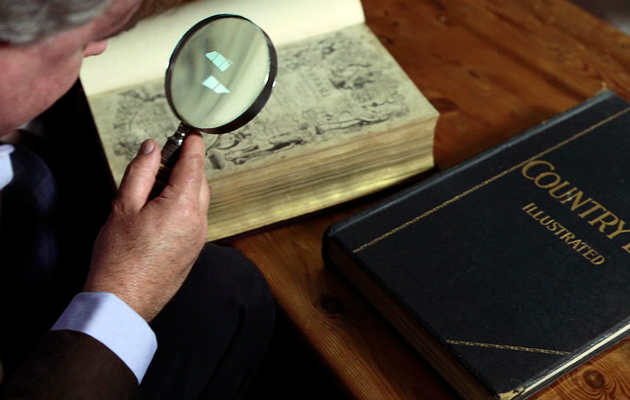
How Country life revealed the true face of Shakespeare [VIDEO]
Country Life magazine reveals an astonishing new image of William Shakespeare, the first and only known demonstrably authentic portrait of
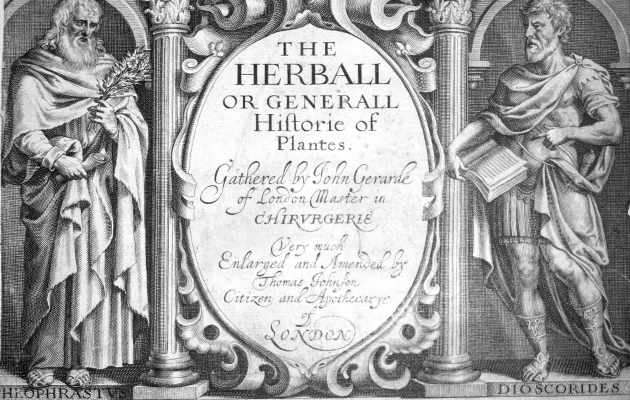
Why the fourth man can't be anybody but Shakespeare
A number of commenters have put forward theories of their own. But does the evidence stack up for them? Mark
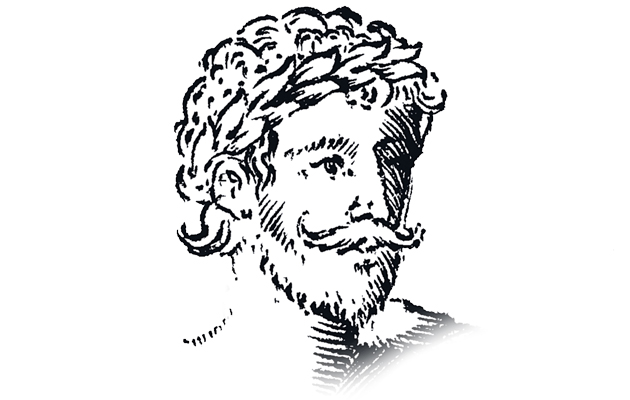
Shakespeare: Apollo reborn
Could the Fourth Man be Dioscorides or Apollo and not Shakespeare? Edward Wilson, Emeritus Fellow of Worcester College, Oxford, thinks

The true face of Shakespeare: Dioscorides and the Fourth Man
Mark Griffiths explains in depth why the Fourth Man is not Dioscorides.
-
 Brideshead Revisited (again): The 10 scene-stealing British country homes from film and television
Brideshead Revisited (again): The 10 scene-stealing British country homes from film and televisionWhat do an enigmatic Caped Crusader, a sopping-wet Mr Darcy and Lord Eddard Stark of Winterfell have in common? Believe it or not, British country houses.
-
 Sophia Money-Coutts: Is it ever okay to throw your dog a birthday party?
Sophia Money-Coutts: Is it ever okay to throw your dog a birthday party?Sir Lewis Hamilton did it, so why not throw a birthday party for your canine companion, Sophia Money-Coutts asks.